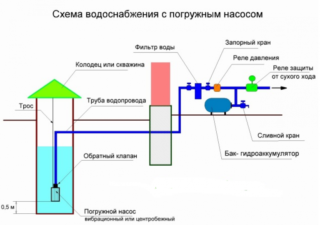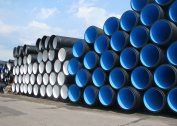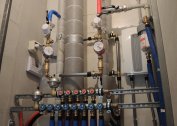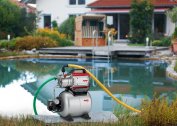Far from centralized water supply networks, a well becomes the main source of water. To supply it to the house, a pipeline is arranged. In order for the fluid to move through the pipes, it is necessary to install a submersible pump in the well. The equipment creates a pressure that raises the water to the desired height. Simultaneously with the installation of the unit, communications are being laid from the source to the house.
Features of installing a submersible pump in a well
Reliable operation of the water supply system provides a pump with optimal performance. When choosing an aggregate, its power, head height, and ability to function in water with pollution are taken into account. Responsible buyers appreciate additional qualities. Models with built-in dry running protection will not fail with a sharp drop in water level.
Two types of submersible pumps are recommended for wells: vibrating and centrifugal. Vibration units have low productivity, but are affordable. Centrifugal mechanisms will provide the house with the right amount of water. Models of well-known companies are characterized by long-term operation.
Installation of a well pump in a well is carried out in two positions:
- Vertical - the position is suitable for mines of any size. The equipment is mounted on one cable.
- Horizontally - location is possible for models in which an engine cooling cover is provided. Manufacturers make eyelets to secure the cable in two places.
One of the installation rules - there should be a distance of 1 m from the bottom of the well to the unit.
Necessary tools and materials
When making a water supply plan, the length of the pipes is calculated and the material of the line is selected. A common option is PVC or propylene products. Plastic pipes do not rust, plaque is not deposited on the walls. To prevent freezing of the highway, a casing-heater made of foamed foam or polyethylene is used. Consumables will be required for the installation of the pipeline:
- couplings;
- tee;
- fitting;
- ball valve.
To suspend the pump, you need a steel frame. For her prepare metal corners. The cable holding the unit must be stainless steel or kapron.
Tools for work:
- shovel;
- hammer drill;
- grinder or hacksaw;
- roulette;
- pipe cutter.
Installation of equipment is best done with a partner. He will help to dig a trench, he will insure when lowering the unit into the well.
Installation Steps
 After the preparation of materials and tools, they begin to install pumping equipment. The work is carried out in stages.
After the preparation of materials and tools, they begin to install pumping equipment. The work is carried out in stages.
Pipeline laying
- The smallest distance from home to the well is selected. The number of bends on the track is taken into account.
- A trench is dug up to a depth of 1.5 m, a width of 0.5 m. A 20 cm layer of sand is poured onto the bottom. Pipes are connected by fittings to a common highway, a heat-insulating casing is put on top.
- A hole is made in the concrete ring of the well shaft and a sleeve is inserted. The gaps around it are sealed with cement mortar and bitumen. Through the sleeve, the pipeline will connect to the pump. A tee is installed at the end of the pipe. One of the exits is diverted under the crane.
The length of the sleeve at the entrance to the mine is 40-50 cm. The diameter of the pipes must match the size of the outlet pipe.
Preparing the pump for immersion
Unit preparation is carried out on the surface. The distance from the connection point of the pipeline to the pump outlet is measured. A pipe or flexible hose of the desired length is cut off.The check valve should be located immediately behind the unit, if it is not in the design, the part is installed by the installer. A pump is laid on a flat area, the end of the pipe is placed near the outlet pipe. A coupling is required to connect them. The compound is sealed with fum tape.
The electric cable is straightened and laid along the pipe. To fix the structure, plastic clamps are recommended. They are worn every 50 cm. The wire should not be stretched, preferably a slight sag. The power cable to the shield is fed through the finished ditch of the water main. To protect the wire from mechanical damage, it is placed in a plastic pipe.
There is an eyelet on the unit housing to secure the safety cable. Do not use a power wire for hanging. The submersible pump is ready to be lowered into the shaft.
Unit immersion in the well
To properly install the pump in the well for water supply in the house, you need a strong welded frame of metal corners with a channel in the middle. It is made to fit the head. The design is mounted on the upper ring of the shaft. The equipment cable is fixed to the frame. The pump is lowered carefully, without swaying. Depending on the weight of the product, you can work together or use a winch. It remains to connect the unit to the pipeline. To do this, you have to go down the stairs to the well. The worker must be insured with a rope.
Automation
The unit is connected directly to the mains in case of rare use. With continuous operation of the equipment, automation is required. The simplest option is a hydraulic accumulator with a pressure switch.
Second generation automation does not require a tank in the system. It responds to pressure in the pipes.
Third-generation devices control the speed of the pump motor. Electronic components provide stable pressure in the water supply network.
Avoiding Common Mistakes
When connecting a submersible pump in the well, beginners make mistakes. Some shortcomings can lead to interruptions in the operation of the equipment or its failure. Common problems include:
- Using a metal cable. Steel becomes covered with rust over time, the strength of the safety cable is lost. A thick nylon cord is preferred.
- Insufficient cross-section of the electric cable. The parameters of the wire for connecting to the network are specified by the manufacturer. Do not take cable of smaller cross-section. It will overheat, equipment outages will begin.
- The lack of a check valve in the system. Most models are equipped with this part, but low-cost products require self-assembly of the valve. Without its installation, water will drain from the pipes after each shutdown of the engine of the unit.
- Low pump location. If the intake opening is close to the bottom, particles of sand and silt will fall into it. The filter gets dirty quickly.
- Mounting the unit near the shaft wall. When the housing is close to the well ring, equipment may be impacted. It is located in the central part of the mine. In case of inevitable contact, the casing is protected with a rubber ring.
Simultaneously with the installation of the pump, it is recommended to include a hydraulic accumulator and an automatic relay in the system. A sealed tank is used to create and maintain pressure in the water supply. The relay controls the on and off of the equipment. Using automation reduces the number of duty cycles. The life of the pump motor is extended. The system is protected from surges in water pressure and water hammer.




